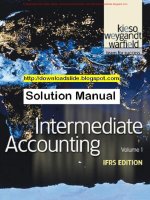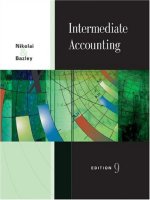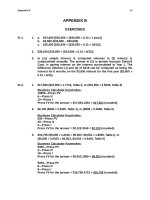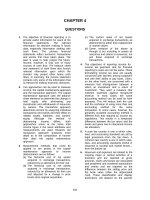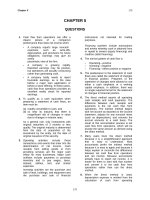Solution manual intermediate accounting 7th by nelson spiceland ch11
Bạn đang xem bản rút gọn của tài liệu. Xem và tải ngay bản đầy đủ của tài liệu tại đây (659.22 KB, 79 trang )
Find more slides, ebooks, solution manual and testbank on www.downloadslide.com
Chapter 11
Operational Assets: Utilization and
Impairment
QUESTIONS FOR REVIEW OF KEY TOPICS
Question 11-1
The terms depreciation, depletion, and amortization all refer to the process of allocating the
cost of an operational asset to periods of use. The only difference between the terms is that they
refer to different types of operational assets; depreciation for plant and equipment, depletion for
natural resources, and amortization for intangibles.
Question 11-2
The term depreciation often is confused with a decline in value or worth of an asset.
Depreciation is not measured as decline in value from one period to the next. Instead, it involves the
distribution of the cost of an asset, less any anticipated residual value, over the asset's estimated
useful life in a systematic and rational manner that attempts to match revenues with the use of the
asset.
Question 11-3
The process of cost allocation for operational assets requires that three factors be established at
the time the asset is put into use. These factors are:
1. Service (useful) life — The estimated use that the company expects to receive from the asset.
2. Allocation base — The value of the usefulness that is expected to be consumed.
3. Allocation method — The pattern in which the usefulness is expected to be consumed.
Question 11-4
Physical life provides the upper bound for service life. Physical life will vary according to the
purpose for which the asset is acquired and the environment in which it is operated. Service life may
be less than physical life for several reasons. For example, the expected rate of technological
changes may shorten service life. Management intent also may shorten the period of an asset’s
usefulness below its physical life. For instance, a company may have a policy of using its delivery
trucks for a three-year period before trading the trucks for new models.
Question 11-5
The total amount of depreciation to be recorded during an asset’s service life is called its
depreciable base. This amount is the difference between the initial value of the asset at its
acquisition (its cost) and its residual value. Residual or salvage value is the amount the company
expects to receive for the asset at the end of its service life less any anticipated disposal costs.
Solutions Manual, Vol.1, Chapter 11
© The McGraw-Hill Companies, Inc., 2007
11-1
Find more slides, ebooks, solution manual and testbank on www.downloadslide.com
Answers to Questions (continued)
Question 11-6
Activity-based allocation methods estimate service life in terms of some measure of
productivity. Periodic depreciation or depletion is then determined based on the actual productivity
generated by the asset during the period. Time-based allocation methods estimate service life in
years. Periodic depreciation or amortization is then determined based on the passage of time.
Question 11-7
The straight-line depreciation method allocates an equal amount of depreciable base to each
year of an asset’s service life.
Accelerated depreciation methods allocate higher portions of
depreciable base to the early years of the asset’s life and lower amounts of depreciable base to later
years. Total depreciation is the same by either approach.
Question 11-8
Theoretically, the use of activity-based depreciation methods would provide a better matching
of revenues and expenses. Clearly, the productivity of a plant asset is more closely associated with
the benefits provided by that asset than the mere passage of time. However, activity-based methods
quite often are either infeasible or too costly to use. For example, buildings do not have an
identifiable measure of productivity. For assets such as machinery, there may be an identifiable
measure of productivity, such as machine hours or units produced, but it is more costly to determine
the amount each period than it is to simply measure the passage of time. For these reasons, most
companies use time-based depreciation methods.
Question 11-9
Companies might use the straight-line method because they consider that the benefits derived
from the majority of plant assets are realized approximately evenly over these assets’ useful lives. It
also is the easiest method to understand and apply. The effect on net income also could explain why
so many companies prefer the straight-line method to the accelerated methods. Straight line
produces a higher net income in the early years of an asset’s life. Net income can affect bonuses
paid to management, or debt agreements with lenders. Income taxes are not a factor in determining
the depreciation method because a company is not required to use the same depreciation method for
both financial reporting and income tax purposes.
Question 11-10
The group approach to aggregation is applied to a collection of depreciable assets that share
similar service lives and other attributes. For example, group depreciation could be used for fleets of
vehicles or collections of machinery. The composite approach to aggregation is applied to dissimilar
operating assets, such as all of the depreciable assets in one manufacturing plant. Individual assets
in the composite may have diverse service lives. Both approaches are similar in that they involve
applying a single straight-line rate based on the average service lives of the assets in the group or
composite.
© The McGraw-Hill Companies, Inc., 2007
11-2
Intermediate Accounting, 4/e
Find more slides, ebooks, solution manual and testbank on www.downloadslide.com
Answers to Questions (continued)
Question 11-11
The allocation of the cost of a natural resource to periods of use is called depletion. The
process otherwise is identical to depreciation. The activity-based units-of-production method is the
predominant method used to calculate depletion, not the time-based straight-line method.
Question 11-12
The amortization of intangible assets is based on the same concepts as depreciation and
depletion. The capitalized cost of an intangible asset that has a finite useful life must be allocated to
the periods the company expects the asset to contribute to its revenue generating activities.
Intangibles, though, generally have no residual values, so the amortizable base is simply cost. Also,
intangibles possess no physical life to provide an upper bound to service life. However, most
intangibles have a legal or contractual life that limits useful life. Intangible assets that have indefinite
useful lives, including goodwill, are not amortized.
Question 11-13
A company can calculate depreciation based on the actual number of days or months the asset
was used during the year. A common simplifying convention is to record one-half of a full year’s
expense in the years of acquisition and disposal. This is known as the half-year convention. The
modified half-year convention records a full year’s expense when the asset is acquired in the first
half of the year or sold in the second half. No expense is recorded when the asset is acquired in the
second half of the year or sold in the first half.
Question 11-14
A change in the service life of an operational asset is accounted for as a change in an estimate.
The change is accounted for prospectively by simply depreciating the remaining depreciable base of
the asset (book value at date of change less estimated residual value) over the revised remaining
service life.
Question 11-15
A change in depreciation method is accounted for prospectively by simply depreciating the
remaining depreciable base of the asset (book value at date of change less estimated residual value)
over the revised remaining service life using the new depreciation method, exactly as we would
account for a change in estimate. One difference is that most changes in estimate do not require a
company to justify the change. However, this change in estimate is a result of changing an
accounting principle and therefore requires a clear justification as to why the new method is
preferable. A disclosure note reports the effect of the change on net income and earnings per share
along with clear justification for changing depreciation methods.
Solutions Manual, Vol.1, Chapter 11
© The McGraw-Hill Companies, Inc., 2007
11-3
Find more slides, ebooks, solution manual and testbank on www.downloadslide.com
Answers to Questions (concluded)
Question 11-16
If a material error is discovered in an accounting period subsequent to the period in which the
error is made, previous years’ financial statements that were incorrect as a result of the error are
retrospectively restated to reflect the correction. Any account balances that are incorrect as a result
of the error are corrected by journal entry. If retained earnings is one of the incorrect accounts, the
correction is reported as a prior period adjustment to the beginning balance in the statement of
shareholders’ equity. In addition, a disclosure note is needed to describe the nature of the error and
the impact of its correction on net income, income before extraordinary item, and earnings per share.
Question 11-17
An impairment in the value of an operational asset results when there has been a significant
decline in value below carrying value (book value). For tangible operational assets and intangibles
with finite useful lives, GAAP require an entity to recognize an impairment loss only when the
undiscounted sum of estimated future cash flows from an asset is less than the asset’s book value.
The loss recognized is the amount by which the book value exceeds the fair value of the asset or
group of assets when the fair value is readily determinable. If fair value is not determinable, it must
be estimated. One method of estimating fair value is to compute the present value of estimated
future cash flows from the asset or group of assets.
For intangible operational assets other than goodwill, if book value exceeds fair value, an
impairment loss is recognized for the differences. For goodwill, an impairment loss is indicated if
the fair value of the reporting unit is less than its book value. A goodwill impairment loss is
measured as the excess of book value of goodwill over its “implied” fair value.
For operational assets held for sale, if book value exceeds fair value, an impairment loss is
recognized for the difference.
Question 11-18
Repairs and maintenance are expenditures made to maintain a given level of benefits provided
by the asset and do not increase future benefits. Expenditures for these activities should be
expensed in the period incurred.
Additions involve adding a new major component to an existing asset. These expenditures
usually are capitalized.
Improvements are expenditures for the replacement of a major component of an operational
asset. The costs of improvements usually are capitalized.
Rearrangements are expenditures to restructure an operational asset without addition,
replacement, or improvement. The objective is to create a new capability for the asset and not
necessarily to extend useful life. The costs of material rearrangements should be capitalized if they
clearly increase future benefits.
© The McGraw-Hill Companies, Inc., 2007
11-4
Intermediate Accounting, 4/e
Find more slides, ebooks, solution manual and testbank on www.downloadslide.com
BRIEF EXERCISES
Brief Exercise 11-1
Depreciation is a process of cost allocation, not valuation. Koeplin should not
record depreciation expense of $18,000 for year one of the machine’s life. Instead, it
should distribute the cost of the asset, less any anticipated residual value, over the
estimated useful life in a systematic and rational manner that attempts to match
revenues with the use of the asset, not the periodic decline in its value.
Solutions Manual, Vol.1, Chapter 11
© The McGraw-Hill Companies, Inc., 2007
11-5
Find more slides, ebooks, solution manual and testbank on www.downloadslide.com
Brief Exercise 11-2
a. Straight-line:
$30,000 - 2,000
= $7,000 per year
4 years
b. Sum-of-the-years’ digits:
Sum-of-the-digits is ([4 (4 + 1)] ÷ 2) = 10
2006
2007
$28,000 x 4/10
$28,000 x 3/10
= $11,200
= $ 8,400
c. Double-declining balance:
Straight-line rate is 25% (1 ÷ 4 years) x 2
= 50% DDB rate
2006
2007
= $15,000
= $ 7,500
$30,000 x 50%
($30,000 - 15,000) x 50%
d. Units-of-production:
$30,000 - 2,000
= $2.80 per unit depreciation rate
10,000 hours
2006
2007
2,200 hours x $2.80 = $6,160
3,000 hours x $2.80 = $8,400
© The McGraw-Hill Companies, Inc., 2007
11-6
Intermediate Accounting, 4/e
Find more slides, ebooks, solution manual and testbank on www.downloadslide.com
Brief Exercise 11-3
a. Straight-line:
$30,000 - 2,000
= $7,000 per year
4 years
2006
2007
$7,000 x 9/12
$7,000 x 12/12
=
=
$5,250
$7,000
b. Sum-of-the-years’ digits:
Sum-of-the-digits is ([4 (4 + 1)] ÷ 2) = 10
2006
$28,000 x 4/10 x 9/12
=
$8,400
2007
$28,000 x 4/10 x 3/12
+ $28,000 x 3/10 x 9/12
=
=
$2,800
6,300
$9,100
c. Double-declining balance:
Straight-line rate is 25% (1 ÷ 4 years) x 2
= 50% DDB rate
2006
= $11,250
2007
or,
2007
$30,000 x 50% x 9/12
$30,000 x 50% x 3/12
+ ($30,000 – 15,000) x 50% x 9/12
= $ 3,750
=
5,625
$ 9,375
($30,000 – 11,250) x 50%
= $ 9,375
Solutions Manual, Vol.1, Chapter 11
© The McGraw-Hill Companies, Inc., 2007
11-7
Find more slides, ebooks, solution manual and testbank on www.downloadslide.com
Brief Exercise 11-4
Annual depreciation will equal the group rate multiplied by the depreciable base
of the group:
($425,000 – 40,000) x 18% = $69,300
Since depreciation records are not kept on an individual asset basis, dispositions
are recorded under the assumption that the book value of the disposed item exactly
equals any proceeds received and no gain or loss is recorded. Any actual gain or loss
is implicitly included in the accumulated depreciation account.
Journal entry (not required):
Cash ..............................................................................
Accumulated depreciation (difference) ...........................
Equipment (account balance) .........................................
35,000
7,000
42,000
Brief Exercise 11-5
$8,250,000
Depletion per ton
=
= $2.75 per foot
3,000,000 cubic feet
2006 depletion
2007 depletion
= $2.75 x 700,000 feet
= $2.75 x 800,000 feet
© The McGraw-Hill Companies, Inc., 2007
11-8
= $1,925,000
= $2,200,000
Intermediate Accounting, 4/e
Find more slides, ebooks, solution manual and testbank on www.downloadslide.com
Brief Exercise 11-6
Expenses for 2006 include:
In-process R & D
=
†
Amortization of the patent
=
*
Amortization of the developed technology =
Total
$2,000,000
400,000
300,000
$2,700,000
Goodwill is not amortized.
†
Amortization of the patent:
($4,000,000 ÷ 5) x 6/12
=
$400,000
*Amortization of the developed technology:
($3,000,000 ÷ 5) x 6/12
=
$300,000
Brief Exercise 11-7
Calculation of annual depreciation after the estimate change:
$9,000,000
$320,000
x 2 years
640,000
8,360,000
500,000
7,860,000
÷ 18
$ 436,667
Solutions Manual, Vol.1, Chapter 11
Cost
Old annual depreciation ($8 million ÷ 25 years)
Depreciation to date (2004-2005)
Undepreciated cost
Revised residual value
Revised depreciable base
Estimated remaining life - 18 years (20-2)
2006 depreciation
© The McGraw-Hill Companies, Inc., 2007
11-9
Find more slides, ebooks, solution manual and testbank on www.downloadslide.com
Brief Exercise 11-8
In general, we report voluntary changes in accounting principles retrospectively.
However, a change in depreciation method is considered a change in accounting
estimate resulting from a change in accounting principle. In other words, a change in
the depreciation method reflects a change in the (a) estimated future benefits from the
asset, (b) the pattern of receiving those benefits, or (c) the company’s knowledge
about those benefits, and therefore the two events should be reported the same way.
Accordingly, Robotics reports the change prospectively; previous financial statements
are not revised. Instead, the company simply employs the double-declining balance
method from now on. The undepreciated cost remaining at the time of the change
would be depreciated DDB over the remaining useful life. A disclosure note should
justify that the change is preferable and describe the effect of the change on any
financial statement line items and per share amounts affected for all periods reported.
Asset’s cost
Accumulated depreciation to date*
Undepreciated cost, Jan. 1, 2006
Double-declining balance depreciation for 2006
$9,000,000
(640,000)
$8,360,000
x 2/23 †
$ 726,957
*$8,000,000 ÷ 25 = $320,000 x 2 years = $640,000
†
Remaining life is 23 years. Twice the straight-line rate is 2/23.
© The McGraw-Hill Companies, Inc., 2007
11-10
Intermediate Accounting, 4/e
Find more slides, ebooks, solution manual and testbank on www.downloadslide.com
Brief Exercise 11-9
If a material error is discovered in an accounting period subsequent to the period
in which the error is made, previous years’ financial statements that were incorrect as
a result of the error are retrospectively restated to reflect the correction. Any account
balances that are incorrect as a result of the error are corrected by journal entry. If
retained earnings is one of the incorrect accounts, the correction is reported as a prior
period adjustment to the beginning balance in the statement of shareholders’ equity.
In addition, a disclosure note is needed to describe the nature of the error and the
impact of its correction on net income, income before extraordinary item, and earnings
per share.
In this case, depreciation of $32,000 should have been $320,000 ($8,000,000 ÷
25 years). Therefore, 2004 income before tax is overstated by $288,000 ($320,000 –
32,000) and accumulated depreciation is understated by the same amount. The
following journal entry is needed to record the error correction (ignoring income tax):
Retained earnings .......................................................... 288,000
Accumulated depreciation ........................................
288,000
Depreciation for 2006 would be $320,000.
Brief Exercise 11-10
Because the undiscounted sum of future cash flows of $28 million exceeds book
value of $26.5 million, there is no impairment loss.
Solutions Manual, Vol.1, Chapter 11
© The McGraw-Hill Companies, Inc., 2007
11-11
Find more slides, ebooks, solution manual and testbank on www.downloadslide.com
Brief Exercise 11-11
Because the undiscounted sum of future cash flows of $24 million is less than
book value of $26.5 million, there is an impairment loss. The impairment loss is
calculated as follows:
Book value
Fair value
Impairment loss
$26.5 million
21.0 million
$ 5.5 million
Brief Exercise 11-12
Recoverability: Because the book value of SCC’s net assets of $42 million
exceeds fair value of $40 million, an impairment loss is indicated.
Determination of implied value of goodwill:
Fair value of SCC
Less: Fair value of SCC’s assets (excluding goodwill)
Implied goodwill
$40 million
31 million
$ 9 million
Measurement of impairment loss:
Book value of goodwill
Less: Implied value of goodwill
Impairment loss
$15 million
9 million
$ 6 million
Brief Exercise 11-13
Recoverability: Because the book value of SCC’s net assets of $42 million is less
than the fair value of $44 million, an impairment loss is not indicated.
© The McGraw-Hill Companies, Inc., 2007
11-12
Intermediate Accounting, 4/e
Find more slides, ebooks, solution manual and testbank on www.downloadslide.com
Brief Exercise 11-14
Annual maintenance on machinery, $5,400 - This is an example of normal
repairs and maintenance. Future benefits are not increased; therefore the
expenditure should be expensed in the period incurred.
Remodeling of offices, $22,000 - This is an example of an improvement. The
cost of the remodeling should be capitalized and depreciated, either by (1)
substitution, (2) direct capitalization of the cost, or (3) a reduction of accumulated
depreciation.
Rearrangement of the shipping and receiving area, $35,000 - This is an
example of a rearrangement. Because the rearrangement increased productivity,
the cost should be capitalized and depreciated.
Addition of a security system, $25,000 - This is an example of an addition.
The cost of the security system should be capitalized and depreciated.
Solutions Manual, Vol.1, Chapter 11
© The McGraw-Hill Companies, Inc., 2007
11-13
Find more slides, ebooks, solution manual and testbank on www.downloadslide.com
EXERCISES
Exercise 11-1
1. Straight-line:
$33,000 - 3,000
= $6,000 per year
5 years
2. Sum-of-the-years’ digits:
Year
2006
Depreciable
Base
$30,000
2007
30,000
2008
30,000
2009
30,000
2010
30,000
Total
© The McGraw-Hill Companies, Inc., 2007
11-14
Depreciation
X Rate per Year =
5
15
4
15
3
15
2
15
1
15
Depreciation
$10,000
8,000
6,000
4,000
2,000
$30,000
Intermediate Accounting, 4/e
Find more slides, ebooks, solution manual and testbank on www.downloadslide.com
Exercise 11-1 (concluded)
3. Double-declining balance:
Straight-line rate of 20% (1 ÷ 5 years) x 2 = 40% DDB rate.
Year
2006
2007
2008
2009
2010
Total
Book Value
Beginning
of Year X
$33,000
19,800
11,880
7,128
4,277
Depreciation
Rate per
Year =
40%
40%
40%
40%
*
Depreciation
$ 13,200
7,920
4,752
2,851
1,277 *
$30,000
Book Value
End of Year
$19,800
11,880
7,128
4,277
3,000
* Amount necessary to reduce book value to residual value
4. Units-of-production:
$33,000 - 3,000
= $.30 per mile depreciation rate
100,000 miles
Year
2006
2007
2008
2009
2010
Totals
Actual
Miles
Driven X
22,000
24,000
15,000
20,000
21,000
102,000
Depreciation
Rate per
Mile =
$.30
.30
.30
.30
*
Depreciation
$6,600
7,200
4,500
6,000
5,700 *
$30,000
Book Value
End of
Year
$26,400
19,200
14,700
8,700
3,000
* Amount necessary to reduce book value to residual value
Solutions Manual, Vol.1, Chapter 11
© The McGraw-Hill Companies, Inc., 2007
11-15
Find more slides, ebooks, solution manual and testbank on www.downloadslide.com
Exercise 11-2
1. Straight-line:
$115,000 - 5,000
= $11,000 per year
10 years
2. Sum-of-the-years’ digits:
Sum-of-the-digits is ([10 (10 + 1)] ÷ 2) = 55
2006
2007
$110,000 x 10/55
$110,000 x 9/55
= $20,000
= $18,000
3. Double-declining balance:
Straight-line rate is 10% (1 ÷ 10 years) x 2
= 20% DDB rate
2006
2007
= $23,000
= $18,400
$115,000 x 20%
($115,000 - 23,000) x 20%
4. One hundred fifty percent declining balance:
Straight-line rate is 10% (1 ÷ 10 years) x 1.5
= 15% rate
2006
2007
= $17,250
= $14,663
$115,000 x 15%
($115,000 - 17,250) x 15%
5. Units-of-production:
$115,000 - 5,000
= $.50 per unit depreciation rate
220,000 units
2006
2007
30,000 units x $.50 = $15,000
25,000 units x $.50 = $12,500
© The McGraw-Hill Companies, Inc., 2007
11-16
Intermediate Accounting, 4/e
Find more slides, ebooks, solution manual and testbank on www.downloadslide.com
Exercise 11-3
1. Straight-line:
$115,000 - 5,000
= $11,000 per year
10 years
2006
2007
$11,000 x 3/12
$11,000 x 12/12
=
=
$ 2,750
$11,000
2. Sum-of-the-years’ digits:
Sum-of-the-digits is {[10 (10 + 1)]/2} = 55
2006
$110,000 x 10/55 x 3/12
= $ 5,000
2007
$110,000 x 10/55 x 9/12
+ $110,000 x 9/55 x 3/12
= $15,000
=
4,500
$19,500
3. Double-declining balance:
Straight-line rate is 10% (1 ÷ 10 years) x 2
= 20% DDB rate
2006
=
$5,750
=
=
$17,250
4,600
$21,850
=
$21,850
2007
or,
2007
$115,000 x 20% x 3/12
$115,000 x 20% x 9/12
+ ($115,000 - 23,000) x 20% x 3/12
($115,000 - 5,750) x 20%
4. One hundred fifty percent declining balance:
Straight-line rate is 10% (1 ÷ 10 years) x 1.5
= 15% rate
2006
=
$ 4,313
=
=
$12,937
3,666
$16,603
2007
$115,000 x 15% x 3/12
$115,000 x 15% x 9/12
+ ($115,000 - 17,250) x 15% x 3/12
Or,
Solutions Manual, Vol.1, Chapter 11
© The McGraw-Hill Companies, Inc., 2007
11-17
Find more slides, ebooks, solution manual and testbank on www.downloadslide.com
2007
($115,000 - 4,313) x 15%
© The McGraw-Hill Companies, Inc., 2007
11-18
=
$16,603
Intermediate Accounting, 4/e
Find more slides, ebooks, solution manual and testbank on www.downloadslide.com
Exercise 11-3 (concluded)
5. Units-of-production:
$115,000 - 5,000
= $.50 per unit depreciation rate
220,000 units
2006
2007
10,000 units x $.50 =
25,000 units x $.50 =
$ 5,000
$12,500
Exercise 11-4
Building depreciation:
$5,000,000 - 200,000
= $160,000 per year
30 years
Building addition depreciation:
Remaining useful life from June 30, 2006 is 27.5 years.
$1,650,000
= $60,000 per year
27.5 years
2006 $60,000 x 6/12 = $30,000
2007 $60,000 x 12/12 = $60,000
Solutions Manual, Vol.1, Chapter 11
© The McGraw-Hill Companies, Inc., 2007
11-19
Find more slides, ebooks, solution manual and testbank on www.downloadslide.com
Exercise 11-5
Asset A:
Straight-line rate is 20% (1 ÷ 5 years) x 2 = 40% DDB rate
$24,000
= $60,000 = Book value at the beginning of year 2
.40
Cost - (Cost x 40%) = $60,000
.60Cost = $60,000
Cost = $100,000
Asset B:
Sum-of-the-digits is 36 {[8 (8 + 1)]÷2}
($40,000 - residual) x 7/36 = $7,000
$280,000 - 7residual = $252,000
7residual = $28,000
Residual =
$4,000
Asset C:
$65,000 - 5,000
= $6,000
Life
Life = 10 years
Asset D:
$230,000 - $10,000 = $220,000 depreciable base
$220,000 ÷ 10 years = $22,000 per year
Method used is straight-line.
Asset E:
Straight-line rate is 12.5% (1 ÷ 8 years) x 1.5 = 18.75% rate
Year 1 $200,000 x 18.75% = $37,500
Year 2 ($200,000 - 37,500) x 18.75% =
© The McGraw-Hill Companies, Inc., 2007
11-20
$30,469
Intermediate Accounting, 4/e
Find more slides, ebooks, solution manual and testbank on www.downloadslide.com
Exercise 11-6
1.
2.
3.
4.
b
b
b
a
Exercise 11-7
Requirement 1
Asset
Stoves
Refrigerators
Dishwashers
Totals
Cost
$15,000
10,000
8,000
$33,000
Residual
Value
$3,000
1,000
500
$4,500
Depreciable
Base
$12,000
9,000
7,500
$28,500
Estimated
Life(yrs.)
6
5
4
Depreciation
per Year
(straight line)
$2,000
1,800
1,875
$5,675
$5,675
Group depreciation rate =
= 17.2% (rounded)
$33,000
Group life
=
$28,500
= 5.02 years (rounded)
$5,675
Requirement 2
To record the purchase of new refrigerators.
Refrigerators .................................................................
Cash ..........................................................................
2,700
2,700
To record the sale of old refrigerators.
Cash ..............................................................................
Accumulated depreciation (difference) ............................
Refrigerators .............................................................
Solutions Manual, Vol.1, Chapter 11
200
1,300
1,500
© The McGraw-Hill Companies, Inc., 2007
11-21
Find more slides, ebooks, solution manual and testbank on www.downloadslide.com
Exercise 11-8
Requirement 1
Cost of the equipment:
Purchase price
Freight charges
Installation charges
$154,000
2,000
4,000
$160,000
Straight-line rate of 12.5% (1 ÷ 8 years) x 2 = 25% DDB rate.
Year
2006
2007
2008
2009
2010
2011
2012
2013
Total
Book Value
Beginning
Depreciation
of Year
X Rate per Year =
$160,000
25%
120,000
25%
90,000
25%
67,500
25%
50,625
*
45,625
*
40,625
*
35,625
*
Depreciation
$ 40,000
30,000
22,500
16,875
5,000
5,000
5,000
5,000
$129,375
Book Value
End of Year
$120,000
90,000
67,500
50,625
45,625
40,625
35,625
30,625
* Switch to straight-line in 2010:
Straight-line depreciation:
$50,625 - 30,625
= $5,000 per year
4 years
Requirement 2
For plant and equipment used in the manufacture of a product, depreciation is a
product cost and is included in the cost of inventory. Eventually, when the product is
sold, depreciation will be included in cost of goods sold.
© The McGraw-Hill Companies, Inc., 2007
11-22
Intermediate Accounting, 4/e
Find more slides, ebooks, solution manual and testbank on www.downloadslide.com
Exercise 11-9
Requirement 1
$4,500,000
Depletion per ton
=
= $5.00 per ton
900,000 tons
2006 depletion
= $5.00 x 240,000 tons
= $1,200,000
Requirement 2
Depletion is part of product cost and is included in the cost of the inventory of
coal, just as the depreciation on manufacturing equipment is included in inventory
cost. The depletion is then included in cost of goods sold in the income statement
when the coal is sold.
Solutions Manual, Vol.1, Chapter 11
© The McGraw-Hill Companies, Inc., 2007
11-23
Find more slides, ebooks, solution manual and testbank on www.downloadslide.com
Exercise 11-10
Requirement 1
Cost of copper mine:
Mining site
$1,000,000
Development costs
600,000
Restoration costs
303,939 †
$1,903,939
†
$300,000 x 25% =
400,000 x 40% =
600,000 x 35% =
$ 75,000
160,000
210,000
$445,000 x .68301* = $303,939
*Present value of $1, n = 4, i = 10%
Depletion:
$1,903,939
Depletion per pound =
= $.1904 per pound
10,000,000 pounds
2006 depletion
2007 depletion
= $.1904 x 1,600,000 pounds = $304,640
= $.1904 x 3,000,000 pounds = $571,200
Depreciation:
$120,000 - 20,000
Depreciation per pound =
= $.01 per pound
10,000,000 pounds
2006 depreciation
2007 depreciation
= $.01 x 1,600,000 pounds
= $.01 x 3,000,000 pounds
=
=
$16,000
$30,000
Requirement 2
Depletion of natural resources and depreciation of assets used in the extraction of
natural resources are part of product cost and are included in the cost of the inventory
of copper, just as the depreciation on manufacturing equipment is included in
inventory cost. The depletion and depreciation are then included in cost of goods sold
in the income statement when the copper is sold.
© The McGraw-Hill Companies, Inc., 2007
11-24
Intermediate Accounting, 4/e
Find more slides, ebooks, solution manual and testbank on www.downloadslide.com
Exercise 11-11
Requirement 1
a. To record the purchase of a patent.
January 1, 2004
Patent ............................................................................ 700,000
Cash ..........................................................................
700,000
To record amortization on the patent.
December 31, 2004 and 2005
Amortization expense ($700,000 ÷ 10 years) .....................
Patent ........................................................................
70,000
70,000
b. To record the purchase of a franchise.
2006
Franchise....................................................................... 500,000
Cash ..........................................................................
500,000
c. To record research and development expenses.
2006
Research and development expense .............................. 380,000
Cash ..........................................................................
380,000
Solutions Manual, Vol.1, Chapter 11
© The McGraw-Hill Companies, Inc., 2007
11-25
